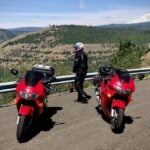The Original Custom Motorcycle
Over motorcycling’s lifespan, there have developed a plethora of customizing genres. From the café racer to the chopper, from brat to rat, the goal of the custom is to recreate a stock motorcycle into a true one-off machine birthed in the imagination of the builder and rider. Motorcycle brands even try to duplicate the styles with what are called “factory customs”, which employ styling cues from various customizing genres. Of all the many and varied styles of customized motorcycles, none is as old and enduring as the Bobber.
By definition, a “bobber” or “bob-job” is a motorbike that has been stripped of extraneous bodywork, its windshield, saddlebags, and other add-ons in an effort to reduce weight and improve performance. The term is derived from “bob-tail”, the practice of removing the tail of an animal, so it was applied to motorcycles with their front and/or rear fenders cut or removed altogether. Many trace the origins of the bobber to the post World War II years, but in actuality, it can be argued that the genre had its origins even earlier.
A fine example of a “Cut-Down”, a restored 1926 Harley-Davidson JD model. Photo by AutoEvolution.
In the 1920s, riders in the States created the “Cut-Down”, whereby they would remove the front fender, cut and shorten the rear, and remove any unnecessary elements of a J-Series Harley-Davidson to make it lighter and improve the handling. Often the frame would be modded, lowering the seat tube and shortening the wheelbase, visually creating a sweeping diagonal line from the steering head to the rear axle. By 1933 the AMA established Class C racing, stating that only catalogued racing motorcycles could be run in sanctioned competition. These stripped down factory racers, like the Indian Daytona Scout and the H-D WR, would become the inspiration for the “Bob-Job”, as road riders copied the racers’ looks and characteristics with their street legal machines.
Following the Second World War, servicemen, sailors, and soldiers returned from combat service abroad and started buying up military surplus motorcycles for pennies on the dollar. The U.S. military, as well as the Brits across the pond, had stockyards full of war-weary machines from all fronts in the war, so war-weary veterans began buying them up and hitting the roads for wind therapy. These riders often “bobbed” their bikes as well, stripping off all the military hardware and repurposing them as civilian machines. Motorcycle customizers like Kenneth “Von Dutch” Howard and others added chrome plating, metal flake paint schemes, pin striping, custom stitched multi-color upholstery, small “peanut” gas tanks and wrapped or upswept exhaust pipes, among other custom elements.
Ray Eddy racing his “Bob-Job” in the AMA Class C Ascot, SoCal series, 1935.
The “Bob-Job” continued to evolve across the 1950s-60s, and the moniker was soon shortened to “Bobber”. Yet a certain look and vibe was always retained- stripped down, streamlined, simplified, and personalized. My father rode a 1954 Triumph Tiger 500 bobber as a teen in the late 1950s, which I’ve written about before HERE. We’ve never found any photos he made of it, but he always gave its description as “chromed frame from end to end, no front fender and only enough rear for a short pillion pad, no speedo, and a non-Triumph pink peanut tank. Stripped and bobbed.”
The bobber genre has endured, even as other custom styles seem to ebb and flow over the years. In 2016, Triumph Motorcycles decided to capture the flair and feel of the bobber’s post WWII era by creating their own Bobber based on their 1200cc parallel twin T120 Bonneville series. They began to sell them in early 2017, and the bike remains a staple of their “Modern Classic” lineup to this day. Sporting a solo seat, a swing cage mounted to a mono-shock under the seat giving the appearance of a floating hard tail, spoked rims and slash-cut low pipes out either side, the Triumph Bobber certainly evokes the storied history of the genre.
2023 Triumph Bobber, photographed at The Towers Venue & Event Space, Monroe, Georgia.
Triumph North America gave us the opportunity to sample one for a month, and being the history nerds that we are, we jumped at the chance. But I had a much deeper reason for wanting to get my hands on one. The bike hearkens back to the bike of my father’s adolescence, and though he is no longer with us, I can imagine him looking this over and remarking, “Yep, reminds me of my old Tiger 500.” When I ride it, I swear I almost feel his presence. Some of his stories with that old Tiger 500 are recalled while I’m out riding this modern version. The nostalgia this bike evokes is deeply personal to me. I own a 2017 Triumph Street Cup which I absolutely love, so I’m continuing his legacy with a Triumph of my own. But to ride this Bobber, reminiscent of the custom bobber he rode, helps me feel connected to him again somehow.
The Triumph Bobber 1200cc parallel twin mill makes 76 HP and 78 ft lbs of torque, but out riding it, the Bobber feels like it’s making more, much more. Running up through the 6 speed gearbox, Phil (who had it for a week himself) and I both have found that 6th almost feels like an overdrive. The bike pulls hard up through each gear, and roars nicely through those slash-cut throats. I wasn’t shifting into 6th until almost 80 mph quite often, as that seemed to be the sweet spot. The gearing forces the rider to shift further up in the rev range than some of the brand’s other Modern Classic offerings, as it feels like it lugs some in each gear if you short-shift like a lot of cruiser and Harley riders do. Take this machine up higher in revs as you shift through the gears, and you’ll be rewarded with its brute strength.
Photographed at the Camp Toccoa at Currahee National Historic Site. Photos by Phil G.
The seat height is a slammed yet slightly adjustable 27.2-27.6 inches, but for my size, the reach to the 31.5 in handlebars had me pulled forward slightly, and with the pegs slightly forward, It’s not a super comfortable all-day ride for me. The gas tank is a little “peanut” in size as well, as you’d expect on a bobber, holding 3.6 gallons of petrol. But with a claimed 55-60 mpg, that makes for about 190-200 miles on a tank. I’m fine with that, given the need to get off the bike and perform some self-chiropractic between fuel stops. Be reminded, this isn’t created to be a long-distance touring machine. It’s a bobber, in name and genre. Triumph has numerous other bikes for long days and road trips.
As one can imagine, that single rear under-seat shock is a jackhammer after any hours in the saddle, but I’m sure my father’s old Tiger 500 bobber was as well. There’s very little to strap luggage to for multi-day trips, although Triumph has an OEM setup for it to affix small bags on either side. But I’m guessing riders who want to road trip won’t be interested in this bike. The Bobber is for another rider, one who wants to connect to an earlier time in motorcycling, and wants to ride a simple, stripped-down, elemental motorcycle for leisurely day rides. Or maybe to touch a loved one long passed, like I do with my father’s memory. For that, this bike is perfect.
Rob
For more on the Triumph Bobber, click here:
*Check out our video ride/review!




























I love this ! This is cool 👍
Great review, rode a ‘65 Tiger in my youth and always regretted letting it go.